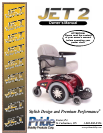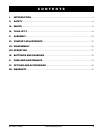
8 www.pridemobility.com Jet 2/Rev F/Feb03
II. SAFETY
WARNING! When climbing an incline, do not zigzag or drive at an angle up the face of the incline.
Drive your power chair straight up the incline. This greatly reduces the possibility of a tip or a fall.
Always exercise extreme caution when negotiating an incline.
WARNING! You should not travel up or down a potentially hazardous incline (i.e., areas covered
with snow, ice, cut grass, or wet leaves).
WARNING! When on any sort of an incline or decline, never place the power chair in freewheel
mode while seated on it or standing next to it. Doing so may result in personal injury and/or damage
to your power chair.
WARNING! Never travel down an incline backwards. This may result in personal injury.
WARNING! Even though your power chair is capable of climbing slopes greater than those illus-
trated in figure 1, do not, under any circumstances, exceed the incline guidelines or any other
specifications presented in this manual. Doing so could cause instability in your power chair, result-
ing in personal injury and/or damage to your power chair.
In compliance with the Americans with Disabilities Act of 1990, all handicap public access ramps are required to
have a maximum slope of 5°. Therefore, Pride recommends that the maximum slope of an incline you attempt to
safely ascend or descend on your power chair does not exceed 5°. See figure 1.
WARNING! Any attempt to climb or descend a slope steeper than 5° may put your power chair in an
unstable position and cause it to flip, resulting in personal injury.
Braking Information
Your power chair is equipped with two powerful brake systems:
1. Regenerative uses electricity to rapidly slow the vehicle when the joystick returns to the center/stop position.
2. Disc Park Brake activates mechanically after regenerative braking slows the vehicle to near stop, or when
power is removed from the system for any reason.
Cornering Information
While your power chair is equipped with rear caster wheels in back and anti-tip wheels in front, excessively high
cornering speeds can still create the possibility of tipping. Factors which affect the possibility of tipping include, but
are not limited to: cornering speed, steering angle (how sharply you are turning), uneven road surfaces, inclined
road surfaces, riding from an area of low traction to an area of high traction (such as passing from a grassy area to
a paved area especially at high speed while turning), and abrupt directional changes. High cornering speeds are
not recommended. If you feel that you may tip over in a corner, reduce your speed and steering angle (i.e., lessen
the sharpness of the turn) to prevent your power chair from tipping.
Figure 1. Maximum Incline and Decline


















